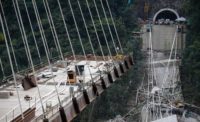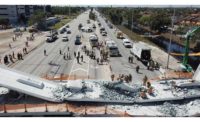Multiple federal investigations into the March 26 collapse of the Francis Scott Key Bridge in Baltimore are focusing not only on what contributed to the incident, but also whether sufficient safeguards are in place to protect bridges and other infrastructure from similar emergencies, particularly given the presence of increasingly large container vessels operating nearby.
Vice Admiral Peter Gautier, the U.S. Coast Guard’s deputy commandant for operations, told members of the House Committee on Transportation and Infrastructure at a May 15 hearing on the federal response to the Key Bridge incident that the growing size and complexity of container ships and other vessels is “placing greater demands on marine transportation infrastructure that may not have kept pace with increased risks that these vessels may pose.”
That’s particularly true for older infrastructure. National Transportation Safety Board Chair Jennifer Homendy told the committee that if the 60-year-old Key Bridge were built today, “it would be built differently.”
NTSB’s preliminary report into the incident, issued the previous day, noted that the pylons supporting the nearly 60-year-old through-truss bridge’s main span across the 700-ft-wide, deep-draft navigation channel were protected by four large dolphins, constructed with a 25-ft-dia sheet pile filled with tremie concrete, capped with reinforced concrete and fitted with 17-ft-long rubber fenders. Each main span pier was also surrounded by a 100-ft x 84.5-ft crushable concrete box and timber fender system.
Those measures proved insufficient to protect the Key Bridge from the container vessel M/V Dali, which was crippled by two successive and still unexplained power outages, and unable to regain propulsion soon after leaving the Port of Baltimore. NTSB’s report says the Dali’s starboard bow drifted past one of the dolphins at 6.5 knots and struck one of the pylons. Six bridge spans collapsed into the water and across the ship’s bow, the report said. Six members of an eight-person bridge maintenance crew were killed in the collapse, and their bodies have since been recovered. A Dali crewmember also sustained minor injuries while escaping the debris.
Homendy told the committee that the power outages were “mechanically distinct” from two that occurred previous day, as Dali crewmembers were performing routine engine maintenance in preparation for the vessel’s planned two-month voyage to Sri Lanka. The outages led the crew to switch to a different transformer and circuit breakers, a not unusual practice, Homendy said, “but it may have affected operations the very next day on the accident voyage.” She added that NTSB investigators have found no issues with the Dali’s fuel, nor is there any evidence of a cyberattack. HD Hyundai Heavy Industries, Co. Ltd., builder of the Dali and its propulsion and electrical system, is a party to the investigation.
Long-term Lessons
Homendy estimated that it may take NTSB up to 18 months to determine the probable cause for the Dali collision. She noted that her agency’s on-site fact-gathering work lasted seven weeks after the incident, which is “an unusual occurrence that speaks to the immense complexity of this event and, therefore, the immense complexity of the investigation.”
Along with continued evaluation of the design and operation of the Dali’s power distribution system, the NTSB is examining pier protection improvements that have been made to other bridges that have experienced marine vessel strikes. They include the Sunshine Skyway Bridge in Tampa Bay, Fla.; the Queen Elizabeth Causeway Bridge near South Padre Island, Texas; and the I-40 Bridge near Webbers Falls, Okla. Worker safety practices for bridge will be examined as well, Homendy said, including the use of advance warning systems.
Calling the Key Bridge incident “a sober reminder” of the risks large vessels post to critical infrastructure, Adm. Gautier says he will convene a nationwide board of inquiry to assess the efficacy and use of the Coast Guard’s suite of risk management tools for port access, with an eye toward establishing “a holistic national-level approach to develop risk profiles, identify ways to address vulnerabilities, and propose actions to reduce risk of major incidents.”
The dynamic nature of the issue was evidenced by the fact that while the House committee hearing was taking place, an untethered barge struck the pillar of a 64-year-old bridge in Galveston, Texas. Damage was limited to an unused rail section of the structure, which the Texas Department of Transportation has already slated for replacement. In early April, a flood event on the Ohio River unmoored several barges wedged, some of which struck a bridge and a lock and dam structure. No significant damage was reported.
Homendy added that while the agency may issue urgent safety recommendations before the final report is complete, states and other bridge owners should be proactive in their risk assessments. “If you have a navigable waterway,” she said, “you should do a risk analysis to ensure safety, to ensure there’s adequate pier protection.”
Recovery and Reconstruction
Since the Key Bridge collapse, a multi-agency unified command has directed a concerted salvage effort to clear thousands of tons of wreckage from the collapse and fully reopen the federal navigation channel by the end of May. Following the successful removal of a 600-ton truss from the Dali’s bow using controlled demolition, the vessel is expected to be refloated the week of May 20 and towed to the Port of Baltimore where it will undergo continued inspection and assessment.
Despite making significant progress over the past two months, the intense recovery effort has strained the Coast Guard and U.S. Army Corps of Engineers’ respective operations and maintenance budgets. Several House committee members expressed concern about the agencies’ ability to fulfill their other missions.
Maj. Gen. William H. Graham, the Corps’ deputy commanding general for civil and emergency operations, said in written testimony that the agency has spent approximately $37 million on wreckage removal and emergency response, including utilizing internal emergency reprogramming of unused operation and maintenance funds from prior year appropriations for the first time since the 2010 response to the Deepwater Horizon oil spill along the Gulf Coast.
“We are taking great care to ensure these reprogramming efforts will not negatively impact other Corps projects,” Gen. Graham said.
Another concern for the committee was the cost and speed of building a replacement structure, particularly with President Biden urging Congress to approve full federal funding of a project with preliminary estimates ranging between $1.7 billion and $1.9 billion.
Federal Highway Administration administrator Shailen Bhatt told the committee that 100% federal funding “would remove the element of uncertainty” for programming a design and construction effort expected to last four years. He added that any payouts from insurance or potential litigation arising from the collisions would also be applied to the project cost.
And as the Key Bridge replacement is to be located within the footprint of the original bridge, Bhatt said the project may qualify for categorical exclusion from National Environmental Policy Act processes.
“We’re working with other agencies to make sure we don’t miss anything,” he said.




Post a comment to this article
Report Abusive Comment